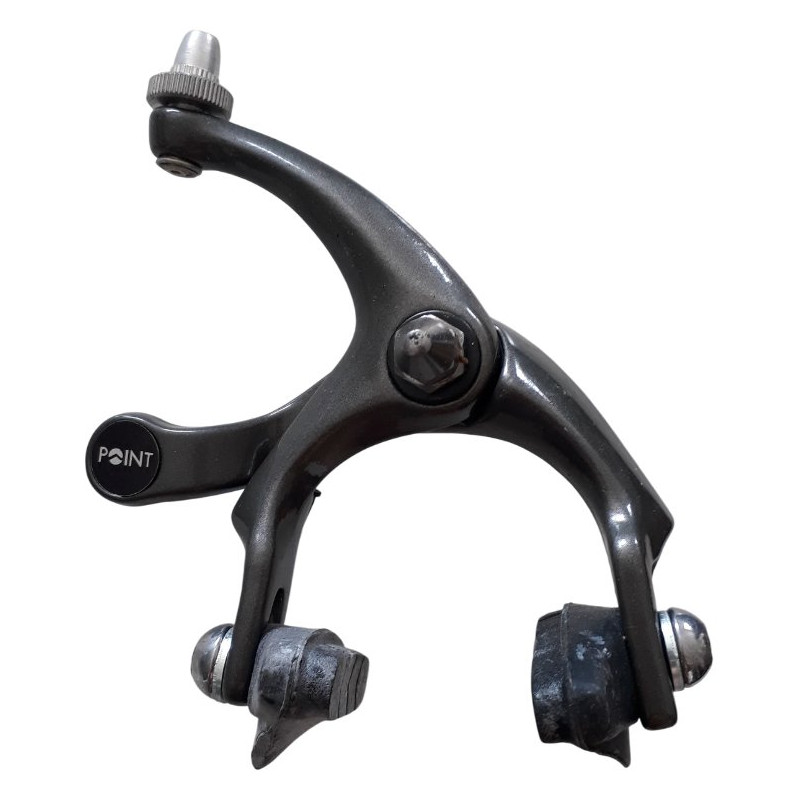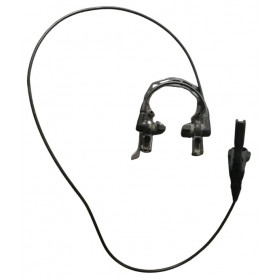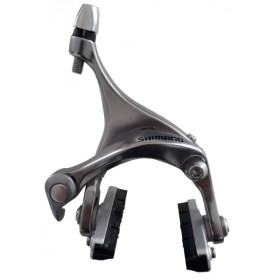 zoom_in
zoom_in
Rear brake for racing bike
- 8 Items
- New
€8.99 VAT included
Road bike brake: everything you need to know about rim brakes
The road bike brake is a crucial component of any performance-oriented bicycle. Whether you're descending a mountain pass, approaching a tight corner, or reacting to a sudden obstacle, the braking system ensures both control and safety. Among the various types of bicycle brakes, rim brakes remain a benchmark for many road cycling enthusiasts.
In this article, we explore the technical features of rim brakes, their advantages, and what you need to consider when choosing or maintaining them.
1. What is a rim brake ?
A rim brake is a mechanical braking system made up of two calipers that press rubber or composite brake pads against the wheel rim when the rider pulls the brake lever. This creates friction, slowing or stopping the wheel's rotation.
Rim brakes are widely used on traditional road bikes, especially in racing, due to their lightweight design, ease of adjustment, and responsive feel.
2. Key features of a road bike brake with rim pads
Here are the main characteristics to keep in mind:
✅ Brake calipers
Rim brakes for road bikes typically use single-pivot or dual-pivot calipers, mounted directly on the front fork and rear seat stays. Dual-pivot models provide stronger braking power and better modulation.
✅ Brake pads
Brake pads are made from specific compounds designed for different rim materials:
-
For aluminum rims: softer compounds offering good grip.
-
For carbon rims: dedicated pads that withstand higher temperatures and reduce overheating.
✅ Cable-actuated system
Rim brakes operate via a cable-actuated mechanism, connecting the calipers to the brake levers on the handlebar. This mechanical setup allows for precise braking force control.
✅ Compatibility
Rim brakes are compatible with most major road groupsets (Shimano, SRAM, Campagnolo). It's essential to check the mounting bolt spacing and pad height alignment with your wheelset.
3. Advantages of rim brakes for road cycling
Despite the growing popularity of disc brakes, the road bike brake with rim pads still offers many benefits:
-
Lightweight: Rim brakes are significantly lighter than disc brakes, ideal for climbing and long rides.
-
Easy maintenance: Replacing pads or adjusting cable tension is quick and straightforward.
-
Cost-effective: Affordable and widely available components.
-
Immediate feel: Direct rim-to-pad contact delivers quick response, favored by experienced riders.
4. Maintenance and adjustments
To ensure reliable and safe braking, regular maintenance is essential:
-
Inspect pad wear: If grooves are shallow or gone, replace the pads.
-
Clean the rim surface: Brake dust and debris can reduce performance.
-
Adjust pad alignment and spacing: Pads should be close to the rim without rubbing.
-
Lubricate the cables: To avoid stiffness or jerky braking.
5. Rim or disc brakes: which is better for a road bike?
While disc brakes now dominate new road bike models for their wet-weather performance and consistent stopping power, rim brakes remain an excellent choice for dry-road riding, offering lighter weight, elegant aesthetics, and a more intuitive braking feel.
Many road cyclists, especially traditionalists and racers, still prefer the simplicity and precision of rim brakes.
Conclusion
The road bike brake with rim pads continues to be a trusted solution for cyclists seeking lightweight performance and mechanical simplicity. With proper care, rim brakes provide strong, smooth, and dependable braking on all dry road surfaces. Whether you're a casual rider or a seasoned racer, choosing the right brake setup is key to maximizing safety, speed, and control.





